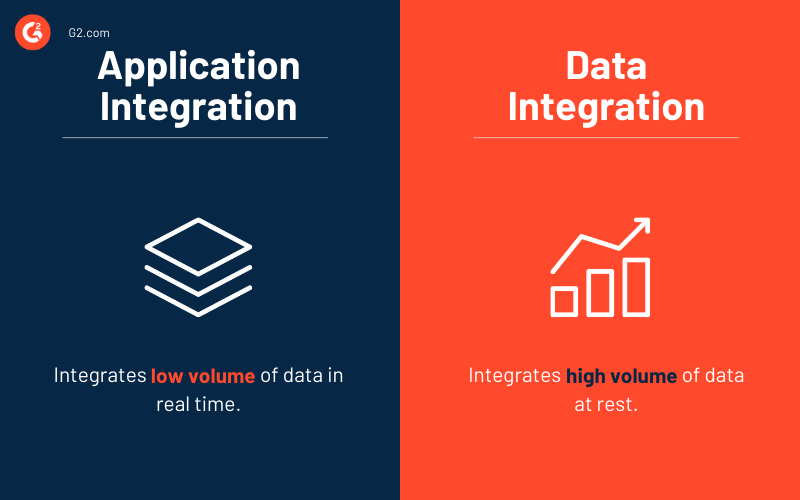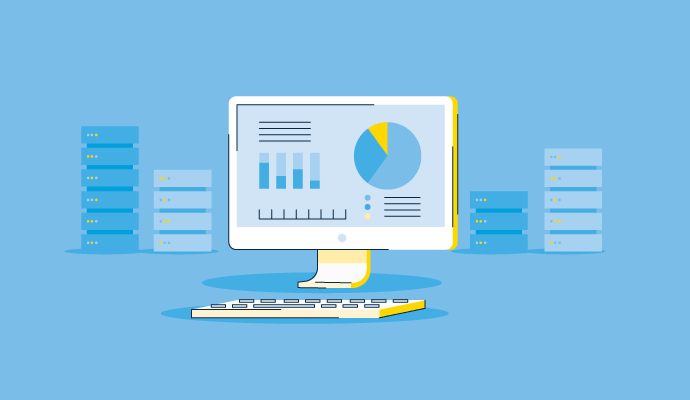Distributed data is like scattered pieces of a puzzle.
You need to organize and arrange it to see the full picture and draw meaningful conclusions. When you look at whole data and understand relationships within it, you gain insights to help you make better business decisions.
On the contrary, making decisions based on inconsistent and siloed data leads to less-informed decision-making.
Data integration helps you analyze disparate data you can use to draw meaningful information. These analytics are paramount to understanding and further optimizing current business operations.
Many organizations use data integration software to pull enterprise data from different sources and format it in one place for better accessibility and analytics.
What is data integration?
Data integration is the process of combining data residing in disparate systems to provide unified access. It allows consistent data delivery to applications and techniques by enabling user access across distributed data through a single platform.
Business processes and applications rely on data to provide valuable insights. It's paramount for data architects to ensure that data stored across various source systems in an organization is easily accessible when needed. With data integration, people or apps can reach distributed data through a single platform, eliminating the silos within data stored across multiple departments.
80%
of enterprise business operations leaders say data integration is critical to ongoing operations.
Source: Forbes
Businesses can realize effective communications, customer service, decision making, and various other benefits by unifying data and allowing seamless access.
Data integration is a potential solution to different pain points related to data management, such as:
- Semantic integration. Data is stored in multiple formats in an organization. For example, you can store a date as MM/DD/YYYY or DD/MM/YYYY, which might challenge users to access correct data points when they are stored and organized differently. The data integration process includes data manipulation that allows accessing accurate data for your needs.
- Big Data. With the increasing volume and variety of data, managing it can become a tedious task. Data integration helps transform the diversified data into meaningful information that guides your decision-making.
- Data silos. There are heterogeneous data sources spread across multiple departments in an organization. In the past, these silos were justified as departments relied on legacy systems with the need for specific data types. With the growing cross-functionality among departments, data integration eliminates such silos and allows seamless data access to multiple departments through a single interface.
- Accessibility. Fetching disparate data is a time-consuming process and is prone to replications and errors. You can increase your team's efficiency by facilitating seamless data access with data integration that allows expeditious access and reduces the possibility of duplicates or mistakes.
You need data to inform business decisions and strategies. Data integration enables you to make sense of data that is stored, formatted, and organized differently, allowing you to streamline business operations.
Why is data integration important?
In the previous decade, data came exclusively from business applications and processes in the absence of smartphones or e-commerce. This data was in a structured format and was stored in data warehouses or data marts, for which extract, transform and load (ETL) developers were primarily responsible. As the volume and complexity of data increased, organizations needed to revamp their data management strategy to make sense of disparate data.
Modern businesses leverage data to guide their decisions, making integration a crucial aspect of data management to help businesses organize, manage and access information without hassle. As big data grows, organizations need to shift toward data integration and embrace its benefits and challenges.
Big data integration: It's an advanced process that automates data integration of massive volume, variety, and velocity of big data. It consolidates data from multiple sources such as social media, websites, and Internet of Things (IoT) devices into one place.
With data integration, businesses can store integrated data in data warehouses or virtually combine models to support business intelligence (BI) and analytics. Moreover, data integration has many use cases industry. For example, it helps record patients' health and performs correct diagnoses in the healthcare industry. Insurance professionals also benefit from its ability to showcase multiple health data from a single platform.
Data integration facilitates better master data management that helps organizations ensure accuracy, stewardship, and connectivity of master data. Several businesses use master data management software that focuses on identifying data. Data integration also supports data migration when organizations adopt new systems or environments.
Möchten Sie mehr über Datenintegrationswerkzeuge erfahren? Erkunden Sie Datenintegrationswerkzeuge Produkte.
Data integration techniques
Data integration managers can adopt different approaches to carry out a data integration project in their company. These approaches include:
- Manual data integration: Data integration managers connect data sources, collect data, and cleanse it manually through custom codes without automation.
- Middleware data integration: A middleware program acts as an interface to connect application sources, primarily used while integrating data stored in legacy systems.
- Application-based integration: A software program carries the integration process to locate, connect, collect, and clean data.
- Uniform access integration: Allows data to stay at its original location and allows unified access to disparate systems.
- Common storage integration: Creates a separate copy of data and stores it in a data warehouse while providing unified access.
Extract, transform, and load
Extract, transform, and load (ETL) is the process of extracting data from heterogeneous or homogeneous sources, transforming it to establish a proper storage format or structure, and loading it into a target database that can be a data lake or warehouse.
ETL processes help organizations cater to business intelligence needs and conduct advanced analytics to improve customer experience. Businesses use ETL tools to create a visual workflow of transferring data while conducting analysis, cleansing, and structuring data.
Top 5 extract, transform, and load tools:
*These are five leading ETL tools from G2's Fall 2021 Grid® Report.
Extract, load, and transform
The extract, load, and transform (ELT) process is an alternative to ETL. Unlike ETL, data isn't transformed when stored in the target database, but instead kept in its original format in the ELT process. The stored data is transformed by request based on specific analytics requirements.
Although the ELT process reduces loading time, it necessitates a data processing engine with high processing capabilities to transform data on demand.
Data virtualization
Data virtualization combines data from disparate sources virtually rather than copying them into a single repository. It creates a logical extraction layer that allows users to access and modify distributed data regardless of its technical details.
Businesses use data virtualization software to enable a unified view and access and apply predictive and visual analytics. It helps data management teams design a clean and concise view of data with gathered insights, helping businesses make informed decisions.
Top 5 data virtualization software:
*These are five leading data virtualization software from G2's Fall 2021 Grid® Report.
Change data capture
Change data capture (CDC) detects changes in source databases in real time and makes the same modifications to data warehouses or data lakes.
Businesses use CDC to minimize resources required in the extract stage of an ETL process. This process has minimal impact on production databases, as no additional queries are required for each transaction. Moreover, you don't need to change the schema of the production databases system or add other tables.
Data replication
Data replication is a process that copies all data from one database and stores it into another to maintain backup and ensure information synchronization. It involves the frequent copying of data from a database to one that allows all users to share the same level of information.
Data replication software facilitates these processes while providing tools to integrate, distribute, and synchronize data across multiple repositories.
Top 5 data replication software:
*These are five leading data replication software from G2's Fall 2021 Grid® Report.
Streaming data integration
Streaming data integration involves consolidating data in real time to provide the most recent and up-to-date information to users. Its need has increased with the increasing number of interconnected devices and the volume of data being stored.
There is a staging area in traditional data integration platforms where data is gathered and processed to load into another system. Since combining data from disparate sources occurs in real time, there is no staging area, and the information is combined instantly without any means to verify synchronization.
Application integration vs. data integration
Application integration works with smaller data sets and facilitates real-time data integration. It helps maintain data consistency regardless of various people or processes updating it in different locations. The data transformation speed is also higher in application integration compared to data integration.

Application integration enables companies to manage new information or performance issues in real time.
On the other hand, data integration works with large data volumes. It usually carries the integration of data at rest after it has been processed to ensure data quality. Data integration gained popularity as relational database adoption increased and the need to move information between them grew.
Within an organization, there's a difference in how application integration and data integration are managed. DevOps manages application integration since it's a part of overall software development operations. Data integration is supervised by DataOps that aligns with the orchestration and management of data.
Data integration best practices
Data integration projects can be tricky to execute as they require resources, time, and buy-ins from various stakeholders. Follow these best practices to carry out data integration in your organization.
Set clear goals
You should set goals representing what you want to achieve through the integration project, whether you want to get a unified view of data or increase marketings’ efficiency by eliminating redundancies
Understand your company’s long-term goals and identify the data integration type that will help achieve them.
Prepare a timescale
Data integration projects take substantial time to reach completion, depending on the type of integration. Prepare a timescale that allocates sufficient time to research and onboard data integration. It’s essential to plan the integration project as skipping steps might extend the implementation timeline.
You should record the time it takes to process data in disparate sources. It’ll help you measure the success of a data integration project after its implementation.
Ensure scalability and fix a budget
Your needs from the data integration platform will grow as your business expands and accumulates more data. Ensure integration solutions are scalable and flexible to accommodate the growing needs of your organization.
Fixing a reasonable budget for the integration project is also important. It will help you select the best solution to cater to your business needs.
Provide training
Beginners in data science might not see the actual value of data integration until you train them. You need to educate them about how to access unified data through a single platform and other necessary details related to data integration tools.
With increased data accessibility, you also need to watch who has access to what and limit privileges when not required. Inform your staff about the best practices to access integrated data and how to use it in their work.
Consider whole data management lifecycle
Think of the complete data management lifecycle while executing data integration. Ensure that data governance is properly enforced and stewards are appointed. This helps a business understand who has control over specific data so people can reach out to them in instances of data quality issues.
Make sure you comply with all industry regulations, such as GDPR or HIPAA. Enforcing data governance also helps you estimate data maintenance costs and forecast the return on investment (ROI) of the data integration project.
Benefits of data integration
Data isn't limited to a particular department in the modern business world. It's exchanged, aggregated, and analyzed from a 360-degree view to make business decisions. For example, when leadership wants to revamp a company's marketing strategy, they need data from websites, social media channels, customer relationship management (CRM) systems, and marketing operations software to analyze the current strategy and modify it.
Data integration allows businesses to view and access data stored across different systems without making requests to every department separately, saving a lot of time. The following are other benefits of data integration.
Strong collaboration with higher efficiency
Data integration provides a self-service solution to access data stored across disparate systems. It addresses the IT department's concern in making data available across different company projects, enabling effective collaboration.
With strenuous data accessibility out of the picture, professionals can build strong collaboration on the grounds of unified data access. They can focus on brainstorming and arriving at the most effective and relevant business decisions in any specific scenario.
Data integration helps increase efficiency and reduces time to access data. Data integration software can further automate the process of collecting and analyzing data. It helps organizations become more productive and competitive as users can save time and focus on more crucial business tasks.
Delivers valuable and error-free data
Managing an organization's data resources isn't easy. Data managers toil to organize and manage data. In the absence of data integration, seeking and accessing data manually can lead to confusion and errors because you have to know where information is stored and the type of data you need.
Accessing data manually might also cause error-prone data. Suppose a professional doesn't know that a data repository was added. They might collect inaccurate data leading to misinformed decisions. Over time, data integration increases the value of data by identifying quality issues and making further improvements to make the most accurate data available and accessible.
Data integration challenges
Although data integration reduces time and effort in the short term, its implementation might create hurdles for an organization in the long term. Below are some challenges your business might face while implementing data integration.
Data integration challenges include:
- Implementation pathway: Companies often know what they need from a data integration solution. However, they usually avoid planning the implementation route to get there. Before adopting a data integration solution, you need to understand the type of data, its location, analysis process, and reporting frequency.
- Legacy systems: Data integration includes data stored in legacy systems with missing markers such as date and time.
- External data: Data stored externally might not carry the exact details as internal data, making it challenging to examine. External vendor regulations also make it questionable to share outside data across organizations.
- Modern data: Businesses generate different types of data, such as structured, unstructured, or real-time. This data comes from IoT devices, sensors, and clouds. Enabling data integration solutions to quickly adapt to present data management needs would pose new challenges to a business.
Once you set up a data integration system, the deed still isn't done yet. You need to manage data integration efforts and optimize them with time to follow best practices in the industry.
Let data guide your decisions
Every data management application is built for a specific purpose. This purpose is to process data in a certain way and help you gain insights. Data integration enables you to make data easily accessible not just for people, but applications as well.
Equip your data management platform with data integration capabilities and make smarter business decisions.
Learn more about data federation and how it enables unified access for users.

Sagar Joshi
Sagar Joshi is a former content marketing specialist at G2 in India. He is an engineer with a keen interest in data analytics and cybersecurity. He writes about topics related to them. You can find him reading books, learning a new language, or playing pool in his free time.

